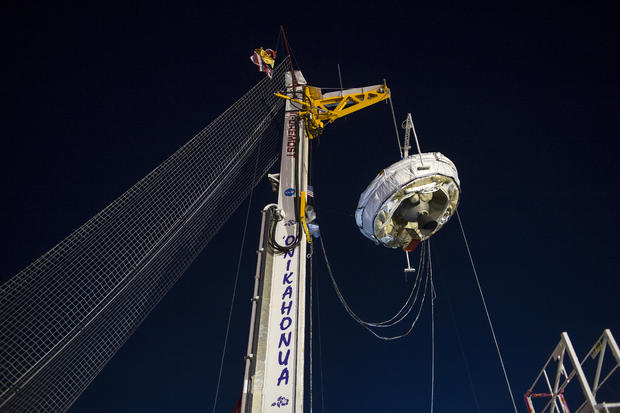NASA Test-Launches JPL's 'Flying Saucer' Mars Lander
Matt Kamlet, CBS Los Angeles
KAUAI, HI (CBSLA.com) — NASA hopes to learn much from Monday's test launch of the vehicle they hope one day will land humans on Mars.
The Low-Density Supersonic Decelerator built and operated by specialists at NASA's Jet Propulsion Laboratory in Pasadena launched Monday on its second test flight in the skies over Hawaii.
The vehicle features the largest supersonic parachute ever constructed with the goal of transferring special payloads onto the Martian surface.
Monday's crucial test launch of the vehicle resulted in a day of mixed successes, as the supersonic parachute only partially opened after deployment. The test flight on Monday took place after a number of weather-related scrubs.
The LDSD was carried to an altitude of 22 miles before stage rockets propelled it further through the stratosphere. Upon burnout, the vehicle was meant to descend to Earth, where it was expected to land gently with the help of the parachute.
As opposed to NASA's Curiosity vehicle, a 1-ton rover that descended to the Martian surface in 2012 through the use of a rocket-powered sky crane, the increased weight demand requires a different descent. The 100-foot-wide parachute is designed to provide safe descent for payloads weighing 5 metric tons or more, including for human missions.
RELATED STORIES:
NASA-Developed Electric Propulsion Tech To Increase Aviation Energy Efficiency By 500 Percent
NASA's SMAP Observatory To Improve Drought Prediction, Planning For Natural Disasters
NASA's Innovative Ground Collision Avoidance System Could Save Hundreds Every Year
NASA Launches Revolutionary OCO-2 Satellite For Climate Study, Avenges 2009 Setback
The parachute did not deploy properly Monday, resulting in a splash-down crash into the Pacific Ocean, similar to its previous test flight.
Despite this, the vehicle's supersonic inflatable aerodynamic decelerator, the saucer-like structure that increases LDSD's surface area to create more drag, did deploy as expected. The SIAD is meant to create drag upon descent to take on part of the responsibility of slowing the vehicle.
The LDSD that launched Monday did contain a black box and a beacon, which JPL scientists hope to examine to learn more about the flight.




